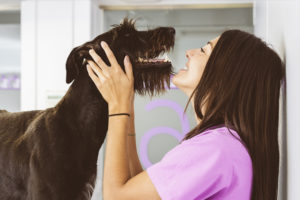
Your pet’s life can be improved by understanding the elements of fear-free handling. Many pet parents are unfamiliar with the science that has led to the relatively new understanding of the permanent emotional damage, behavioral issues, and lack of quality of life that fear and stress may impart on our pets.
A growing body of evidence shows that animals have heightened memory of handling when fearful, which creates a cycle of increased anxiety, and sometimes aggression. Fear and anxiety cause autonomic arousal of the hypothalamic-pituitary-adrenal axis and accompanying release of stress hormones, leading to increased susceptibility to disease secondary to suppression of the immune system.
Dr. Laurie Brush of Heaven at Home Pet Hospice has the opportunity to hear directly from the champion and founder of the Fear-Free movement during the upcoming International Association for Animal Hospice and Palliative Care (IAAHPC) annual conference.
“The Fear-Free movement spearheaded by Dr. Marty Becker has revolutionized veterinary care and is especially relevant to my work offering peaceful, pain-free, fear-free palliative care and at home euthanasia services,” Dr. Brush said.
Dr. Becker had an epiphany in 2009 while listening to PHD animal behaviorist Karen Overall describe the permanent damage fear causes in the amygdala – the part of the brain that is home to the fight or flight instinct. She said fear was “the worst thing a social species could experience. “
He realized the traditional pet-handling techniques he was taught as a veterinarian were inducing stress in his fur-clients, from the stress of being put up on a table to the fear pheromone scent detected in urine outside the clinic.
Simple protocols, such as using calming pheromones and offering anxiety-reducing medications, plus using gentle handling down at the animal’s level with a complement of treats, could break the cycle of fear.
He reached out to peers across the country and over the course of six years developed a protocol and certification program that promotes fear-free techniques that “put the treat in treatment.”
Today, 21 of the nation’s 30 veterinary schools require certification in fear-free veterinary techniques to graduate. More than 75,000 veterinarians in the U.S. are certified.
“One man’s vision has altered the quality of life of millions of companion animals,” said Dr. Brush.
If you’d like to learn more about adopting fear-free strategies at home, visit FearFreePets.com for tips.
